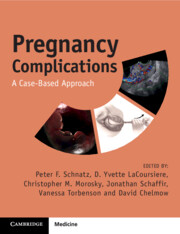Book contents
- Pregnancy Complications
- Pregnancy Complications
- Copyright page
- Contents
- Contributors
- Preface
- Note from the Editor-in-Chief
- Normal Laboratory Values (Conventional Units) []
- Section 1 Antepartum (Early Pregnancy)
- Case 1 A Patient of Ashkenazi Jewish Ancestry Presents for Preconception Counseling
- Case 2 A Patient with a Subchorionic Hematoma Presents with Early Vaginal Bleeding
- Case 3 A 25-Year-Old with a Twin Gestation at 9 Weeks
- Case 4 A 35-Year-Old with HSIL Cervical Cytology at 10 Weeks
- Case 5 A 20-Year-Old with a Molar Pregnancy at 8 Weeks
- Case 6 A 20-Year-Old with Anxiety and Depression at 7 Weeks
- Case 7 A 40-Year-Old with Nausea, Vomiting, and Weight Loss at 7 Weeks
- Case 8 A 30-Year-Old with Worsening Migraine Headaches at 14 Weeks
- Case 9 A 30-Year-Old with Isoimmunization at 9 Weeks
- Case 10 A 25-Year-Old with an Early Pregnancy and Bicornuate Uterus
- Case 11 Recommended Vaccinations at an 8-Week Prenatal Intake
- Section 2 Antepartum (Mid-trimester)
- Section 3 Antepartum (Late Pregnancy)
- Section 4 Antepartum (Medical Complications)
- Section 5 Antepartum (Infectious Complications)
- Section 6 Intrapartum/Delivery
- Section 7 Postpartum
- Section 8 Fetal Complications
- Section 9 Placental Complications
- Section 10 Complications of the Cord, Amnion, and Gravid Uterus
- Section 11 Psychosocial Considerations
- Index
- References
Case 5 - A 20-Year-Old with a Molar Pregnancy at 8 Weeks
from Section 1 - Antepartum (Early Pregnancy)
Published online by Cambridge University Press: 08 April 2025
- Pregnancy Complications
- Pregnancy Complications
- Copyright page
- Contents
- Contributors
- Preface
- Note from the Editor-in-Chief
- Normal Laboratory Values (Conventional Units) []
- Section 1 Antepartum (Early Pregnancy)
- Case 1 A Patient of Ashkenazi Jewish Ancestry Presents for Preconception Counseling
- Case 2 A Patient with a Subchorionic Hematoma Presents with Early Vaginal Bleeding
- Case 3 A 25-Year-Old with a Twin Gestation at 9 Weeks
- Case 4 A 35-Year-Old with HSIL Cervical Cytology at 10 Weeks
- Case 5 A 20-Year-Old with a Molar Pregnancy at 8 Weeks
- Case 6 A 20-Year-Old with Anxiety and Depression at 7 Weeks
- Case 7 A 40-Year-Old with Nausea, Vomiting, and Weight Loss at 7 Weeks
- Case 8 A 30-Year-Old with Worsening Migraine Headaches at 14 Weeks
- Case 9 A 30-Year-Old with Isoimmunization at 9 Weeks
- Case 10 A 25-Year-Old with an Early Pregnancy and Bicornuate Uterus
- Case 11 Recommended Vaccinations at an 8-Week Prenatal Intake
- Section 2 Antepartum (Mid-trimester)
- Section 3 Antepartum (Late Pregnancy)
- Section 4 Antepartum (Medical Complications)
- Section 5 Antepartum (Infectious Complications)
- Section 6 Intrapartum/Delivery
- Section 7 Postpartum
- Section 8 Fetal Complications
- Section 9 Placental Complications
- Section 10 Complications of the Cord, Amnion, and Gravid Uterus
- Section 11 Psychosocial Considerations
- Index
- References
Summary
Molar pregnancies, characterized by abnormal placental tissue growth, are rare but clinically significant conditions. Advancements in ultrasound and hCG assays have transformed the diagnosis of molar pregnancies. Maintaining a high index of suspicion is important for proper diagnosis, especially in cases of first-trimester vaginal bleeding. Certain clinical and laboratory features help distinguish between complete and partial molar pregnancies, including subtle sonographic findings and hCG levels. Histologic confirmation remains essential. The primary therapeutic approach for molar pregnancies is suction dilation and curettage, often with ultrasound guidance. Rhogam administration is important for Rhesus-negative patients, and uterotonics and blood products should be made immediately available during evacuation procedures. Hysterectomy is considered for presumed complete molar pregnancies in patients who have completed childbearing. Postoperative surveillance of serum hCG levels is critical for detecting postmolar gestational trophoblastic neoplasia. This case outlines diagnostic criteria for postmolar GTN, including hCG trends and potential complications. It also emphasizes the importance of contraception for accurate postoperative monitoring. Despite an increased risk of recurrence with a history of molar pregnancy, subsequent normal pregnancies are common following treatment. Early first-trimester ultrasounds and post-pregnancy hCG assessments are recommended for favorable outcomes in future pregnancies.
Keywords
- Type
- Chapter
- Information
- Pregnancy ComplicationsA Case-Based Approach, pp. 13 - 15Publisher: Cambridge University PressPrint publication year: 2025

